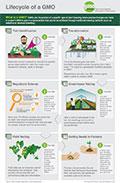Question
Have any crops using selective breeding been bred for the specific traits of either herbicide resistance or insecticide generation?
Submitted by: Nrrd is the wrrd
Answer
Expert response from Christopher Barbey
PhD Student, Plant Molecular Genetics and Cell Biology
Friday, 08/05/2015 13:50
The answer to both is yes, and how this is typically accomplished is an interesting scientific and political intersection that reveals the failings of the “traditional” breeding vs. GM paradigm.
A prominent example of breeding for herbicide tolerance is the “Clearfield” brand of plants, developed by the company BASF. These plants are insensitive to herbicidal inhibitors of the plant enzyme ALS1. Insensitivity to ALS inhibitors has naturally evolved several independent times in plants, always due to various mutations within ALS gene2.
To introduce tolerance of ALS-inhibitors into other crops, the first approach was to test the wild varieties for naturally-occurring herbicide tolerance. If such an ALS-mutation exists in an organism that is sexually-compatible with your crop, it is then a matter of breeding the herbicide trait into your commercially relevant variety (and then typically crossing out the undesirable traits that came with it). This is how Clearfield Sunflower was developed3. If no such mutation occurs among sexually-compatible individuals in your crop, the mutation can be induced to occur in a routine, eighty-decade old traditional breeding process called “mutagenesis breeding”4.
Recall that genetic variation is simply a consequence of random mutation. The rate at which random mutations accumulate can be accelerated using chemical or physical mutagens, such as ionizing radiation5. These novel mutations represent new sources of genetic variation that, if beneficial, can then be bred into commercially-relevant plant varieties as described above. This is how the desired ALS mutation in wheat was developed6. Mutagenesis breeding is a common technique within “traditional” plant breeding methods, and it has been used to make over a thousand currently-cultivated plant varieties world-wide, from Japanese pears to American grapefruits (full registry here)7.
Now here is the interesting political part. Mutagenic varieties are widely grown and promoted by the American organic agriculture industry8, which is supposedly vehemently against “genetic modification.” This inconsistency is particularly exasperating, as organic promoters readily accept mutagenic varieties as safe without feeling the need for any evaluation whatsoever8, despite the presence of any number of induced and uncharacterized genetic mutations. This is in stark contrast to the current rigorous, multimillion-dollar mandatory federal safety/environmental regulatory regime for transgenic GMOs9 (to say nothing of the continued cry for additional regulation, or outright bans). In reality, transgenic GMOs offer almost infinitely fewer unknowns than even a single conventional-breeding cross does (even without mutagenesis), as the only change made to an already-familiar cultivated variety is the addition or subtraction of a specific, well-characterized gene or genes10. Furthermore, the development process for transgenic GMOs includes no special potential for inducing genetic mutations throughout the genome10, 11. The US National Academy of Sciences states that there is no scientific justification to exclude GMOs while including mutagenesis, and adds “induced mutagenesis is the most genetically disruptive and, consequently, most likely to display unintended effects from the widest potential range of phenotypic effects”10.
As for breeding for insect resistance, I offer you two curious cases: psoralen celery and the solanine-producing “Lenape” potato11. In the psoralen celery case, levels of the insecticidal compound psoralen were bred (through conventional methods) to be so high that it unfortunately also gave rashes to farm workers and grocery stockers12. Similarly, the solanine potato was also selected by breeders for its ability to produce high-levels of the insecticidal glycoalkaloid solanine (indirectly recognizable in the greening of a potato tuber exposed to sunlight). Unfortunately, it was later found that it constantly produced far too much solanine even without the induction of sunlight, and people who ate these potatoes became seriously ill13.
- Pfenning, M., G. Palfay, and T. Guillet. "The CLEARFIELD® technology–A new broad-spectrum post-emergence weed control system for European sunflower growers." Journal of Plant Diseases and Protection, Special 21 (2008): 649-653.
- Oard, James H., Nengyi Zhang, and Dearl E. Sanders. "Resistance to acetolactate synthase-inhibiting herbicides." U.S. Patent Application 12/303,888.
- Baumgartner, Jolene R., Kassim Al-Khatib, and Randall S. Currie. "Cross-resistance of imazethapyr-resistant common sunflower (Helianthus annuus) to selected imidazolinone, sulfonylurea, and triazolopyrimidine herbicides." Weed technology (1999): 489-493.
- Kharkwal, M. C., R. N. Pandey, and S. E. Pawar. "Mutation breeding for crop improvement." Plant Breeding. Springer Netherlands, 2004. 601-645.
- van Harten, Anton Marcus. Mutation breeding: theory and practical applications. Cambridge University Press, 1998.
- Mergoum, Mohamed, et al. "Breeding for CLEARFIELD Herbicide Tolerance: Registration of ‘ND901CL’Spring Wheat." Journal of plant registrations 3.2 (2009): 170-174.
- FOA/IAEA, Mutation Enhanced Technologies for Agriculture, Retrieved May 7, 2015
- McEvoy M., U.S. Department of Agriculture National Organic Program. Cell Fusion Techinques Used in Seed Production. NOP Policy Memo 13-1
- McHughen, Alan, and Stuart Smyth. "US regulatory system for genetically modified [genetically modified organism (GMO), rDNA or transgenic] crop cultivars." Plant biotechnology journal 6.1 (2008): 2-12.
- Committee on Identifying and Assessing Unintended Effects of Genetically Engineered Foods on Human Health, National Research Council, et al. Safety of Genetically Engineered Foods: Approaches to Assessing Unintended Health Effects. National Academies Press, 2004
- NAS (1989) Field Testing Genetically Modified Organisms: Framework for Decisions. Washington DC: National Academies Press. URL http://books.nap.edu/catalog/1431.html[accessed on 5-7-2014].
- Seligman, Paul J., et al. "Phytophotodermatitis from celery among grocery store workers." Archives of dermatology 123.11 (1987): 1478-1482.
- Zitnak, A., and G. R. Johnston. "Glycoalkaloid content of B5141-6 potatoes."American Potato Journal 47.7 (1970): 256-260.
